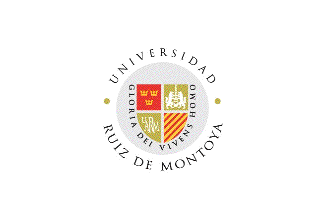
Last modified: 2021-08-25 by rob raeside
Keywords: universidad antonio ruiz de montoya |
Links: FOTW homepage |
search |
disclaimer and copyright |
write us |
mirrors
 image by Ivan Sache, 13 July 2014
image by Ivan Sache, 13 July 2014Universidad Antonio Ruiz de Montoya (UARM), based at Lima, is the follower of
Jesuit colleges that emerged in Peru in the 16th-18th centuries. Founded in the
20th century, the "Instituto de Humanidades Clásicas" (Institute of Classical
Humanities) was reestablished in 1991 as the "Escuela de Pedagogía, Filosofía y
Letras Antonio Ruiz de Montoya" (College of Pedagogy, Philosophy and Literature
Antonio Ruiz de Montoya, eventually renamed UARM in 2003.
UARM is named for Antonio Ruiz de Montoya, a Lima-borne Jesuit father
(1582-1652). Montoya founded several Jesuit missions ("reductions") in Guayra,
ruling 39 of them when appointed head of the missions in 1620. In 1631, he
organized the transport of 15,000 Christian Indians, threatened by the Brazilian
slave hunters,to the safer missions located in Paraguay. Montoya obtained in
1637 from King Philip IV of Spain several privileges and measures of protection
for the Paraguyan missions.
Montoya also wrote seminal books on the Guaraní language and a noted history of
the Paraguay missions.
The flag of UARM is white with the seal-like emblem of the university in the
middle.
The emblem of UARM is made of the university's arms, placed on a grey disk and
surrounding by the black writing "UNIVERSIDAD" (top) / "RUIZ DE MONTOYA"
(bottom). The arms of UARM are "Quarterly, 1. Gules three crowns or placed two
and one, 2. Vert a cauldron flanked by two wolves argent, 3. Vert a monogram
"UARM" argent, 4. Gules five bends or. The shield surrounded by the motto
"GLORIA DEI VIVENS HOMO" in letters sable."
Source: UARM website
The sinister part of the arms is related to Ignatius de Loyola, see
Unidad Educadiva San Felipe Neri for more
details.
Photos of the flag are shown:
- on the UARM website,
President's introduction
- on the PUCP photo gallery, 5th Joint Symposium of Students in Philosophy,
20-23 October 2009 -
Album -
Photo
Ivan Sache, 09 January 2010
"Gloria dei vivens hiomo" (Irenaeus, Adversus Haereses [Against Heresies] IV,
20, 7) translates as "The glory of God is a living ma," Irenaeus' aphorism has
been the subject of several interpretations. In his "Letter to priests for Holy
Thursday, March 17, 1996", Pope John Paul II wrote:
"6. Gloria Dei vivens homo. These words of Saint Irenaeus profoundly link the
glory of God and man's self-realization. "Not to us, O Lord, not to us but to
your name give glory" (Ps 115.1 j: repeating often these words of the Psalmist,
we come to understand that "realizing' ourselves in life has a point of
reference and an end which are transcendent, both of them included in the
concept of the "glory of God": we are called to make our life an officium
laudis".
St. Ireneaus (d. c. 202), Bishop of Lyon, is an early church father. "Against
Heresies" was mostly targeted to the Gnosticis, who relied on a secrete, oral
tradition, as opposed to the canonical, scriptural tradition controlled by the
episcopate.
Ivan Sache, 09 January 2010
There is a picture where full UARM flag is depicted, not only its part:
http://www.utec.edu.pe/noticias-firma-convenio-utec-uarm.html
Zoltan Horvath, 11 April 2012